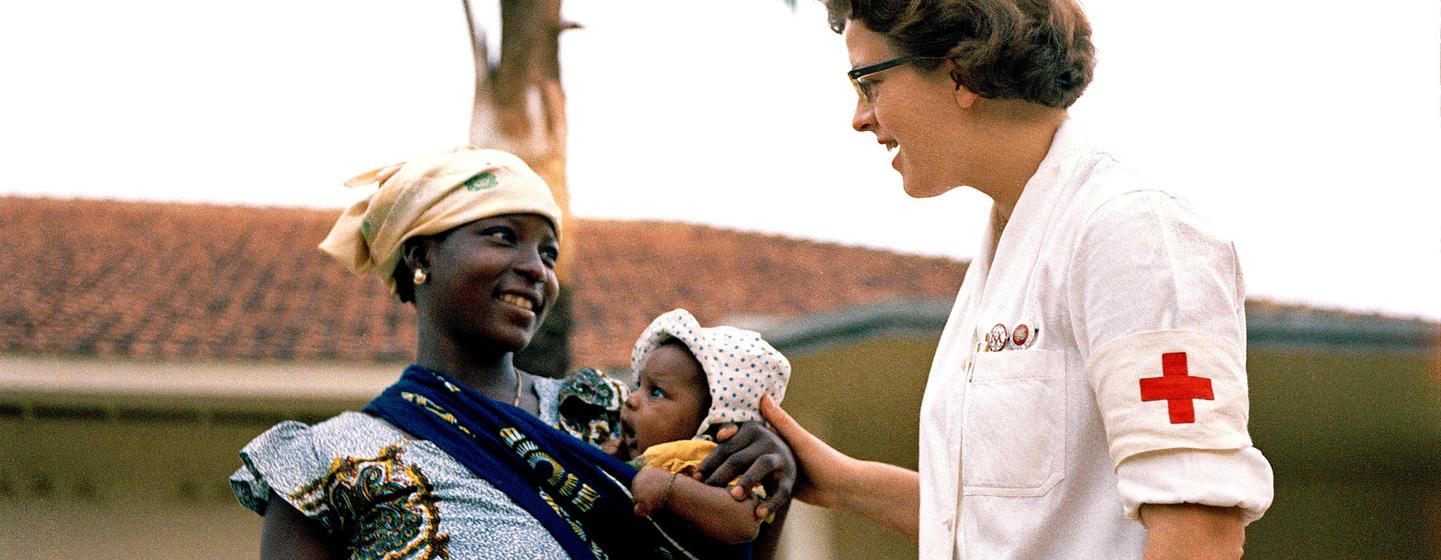Stories from the UN Archive: Magic suitcases for 1960s midwives
On the International Day to End Obstetric Fistula, marked annually on 23 May, we are taking a look at the important role of midwives and tuning in to UN Radio’s featurette from 1963, The Magic Suitcase, narrated by Hollywood star Jack Benny.
The radio and television entertainer joined the UN Children’s Fund (UNICEF) in the 1960s to raise awareness about reproductive health care and the key role midwives played around the world, especially where child mortality was high.
Mr. Benny takes listeners to Thailand, following the story of a family and the joyous birth of a healthy baby after a local midwife arrived on her bicycle with her own magic suitcase.
Listen to the full UN Radio Classics episode here.

Part of UNICEF’s programme to help women give birth safely included training midwives and shipping what Mr. Benny referred to as “magic suitcases” around the world.
In the photo above, from 1954, Yupa Sookchareon (second from left) was testing a fetal stethoscope from one of the 14,000 aluminum midwife kits UNICEF had been preparing to send to practicing midwifes in 27 countries of Asia, the Middle East, Europe, Africa and Latin America.
Ms. Sookchareon, a nurse studying at New York City’s Maternity Center Association on a six-month fellowship from the Government of Thailand, would return to the Bangkok Sanitorium and Hospital as a supervisor for midwife training.
Meanwhile, the midwife kits were being assembled at a Jersey City warehouse at the rate of 700 a day.
They would be distributed by governments to graduates of UNICEF-assisted midwife training courses in their countries.
The kits contained a range of lifesaving tools that a traditional midwife could take to a woman in labour, including a sharp knife, gauze, gloves and a bottle of antiseptic fluid.
For decades, these kits have been helping to save the lives of mothers and newborns worldwide.
That continues today.
‘Thanks to midwives, births are safer’
UNICEF and the UN sexual and reproductive health agency, UNFPA, run programmes around the world for midwives, offering tools and training.
Well-trained midwives working in a fully functional environment could help avert roughly two thirds of all maternal and newborn deaths, according to the most recent State of the World’s Midwifery report.
Since 2008, UNFPA has worked with partners, governments and policymakers to help build a competent, well-trained and well-supported midwifery workforce in low-resource settings.
“Right now, around the world, millions of lives are in the hands of midwives,” said UNFPA Executive Director Natalia Kanem on the International Day of the Midwife, marked annually on 2 May.
“Whether they are wading through flood waters to reach pregnant women or delivering babies amid the rubble of an earthquake, midwives are the unsung heroes of community health services,” she said. “Thanks to midwives, births are safer.”
Keeping with the times, UNICEF has updated its mid-century magic suitcases and standardised its midwifery kit, which now contains basic medicines and equipment for midwives to handle 50 normal deliveries.
Check out what’s inside UNICEF’s latest midwifery kits below:
UN News’s #ThrowbackThursday series showcases epic moments and individuals across UN history, cultivated from the UN Audiovisual Library’s 49,400 hours of video and 18,000 hours of audio recordings and from archives preserved across the UN and its agencies.
Catch up on UN Video’s Stories from the UN Archive playlist here and our accompanying series here.
Join us next Thursday for another dive into history.
Is obstetric fistula preventable? Can midwives help?

The answer to both questions is yes. Indeed, the theme for the International Day to End Obstetric Fistula is Breaking the cycle: Preventing fistula worldwide. Here are some fast facts from the UN sexual and reproductive health agency, UNFPA, about one of the most serious and tragic childbirth injuries:
- What’s fistula? Without access to medical treatment, women experiencing prolonged, obstructed labour face the risk of fistula, a hole between the birth canal and bladder and/or rectum that often leads to chronic health problems, social isolation and deepening poverty
- Half a million women and girls, mostly in developing countries, live with the injury around the world, with new cases occurring every year
- Midwives provide the majority of first-line maternity care and are key to preventing fistula and other childbirth injuries
In 2018, the UN General Assembly adopted a resolution to end obstetric fistula by 2030, and UN agencies from UNICEF to UNFPA have highlighted the urgent need to address the issue comprehensively through equitable access to quality maternal health services, social reintegration and sustained investment in healthcare systems

